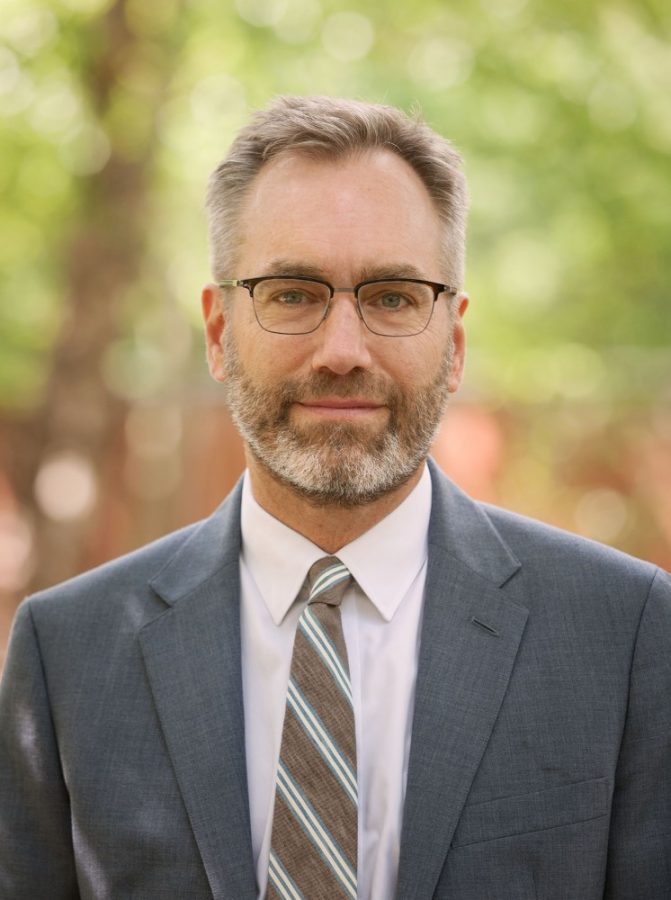The University of Arizona now has a vice president for the arts, a position that President Dr. Robert C. Robbins said will increase the university’s cultural profile.
As the new VP for the arts, Andrew Schulz, dean of the College of Fine Arts, will oversee the School of Art; the Fred Fox School of Music; the School of Dance; the School of Theatre, Film & Television; UA Presents; the Hanson Film Institute and the College of Fine Arts in schools.
Schulz says that the position, which is rare at universities across the country, will help raise the profile and increase the visibility of his mission to integrate the arts within academics and extracurricular activities.
Schulz and Robbins are developing a strategic plan to address the immediate and long-term needs of the art programs. They are primarily focusing on how students, regardless of their major, can have a meaningful experience in the arts.
Schulz said only 3 percent of students at the UA are involved in the arts programs as majors.
Nursing sophomore Zoe Barnes said she’s never been to an arts production on campus, and neither have her friends.
“I don’t think that the UA is an arts school, particularly. For other schools, fine arts are more their focus, but this school isn’t focused on that,” she said. “This school is more of a science-based, medical school.”
Barnes also added that, from her perspective, not many students are aware of performances on campus. This is exactly what Schulz hopes to change. Schulz said he hopes to turn the university’s focus onto integrating the arts into all aspects of students’ lives.
RELATED: Defining artistic culture at UA
Primarily, Schulz has plans to create an arts district that runs from Speedway Boulevard to Second Street and Park Avenue to Olive Road.
It’s not just about what happens inside the buildings,” he said. “It is also about the feel and look of campus. How do we get people to stop by on their way home and take a look at something that is interesting and intriguing?”
Schulz said he’s also looking at performance spaces on campus, many of which he said are in need of “deferred maintenance.”
“This [College of Fine Arts] complex was really forward looking when it was created in the late 1950s. And all of these buildings, the foundation of them is from the 1950s. It was renovated and revised a little bit in the ’90s,” Schulz said. “We need to devise a strategy, which is what we’re doing right now, of how we’re going to create facilities that match the excellence of what we’re doing here.”
Centennial Hall was built in 1936 and opened in April of 1937 as an auditorium. It wasn’t until 1985 and a $4.3 million renovation that it was rechristened as Centennial Hall to celebrate the UA’s centennial year. Among those improvements were a new sound system, lighting, fire alarms and a bigger stage.
Within the strategic plan, Schulz said he hopes the UA will build a new theater that can seat about 800 to 1,200 people, since the majority of events on campus fall in this range. The UA has at least five venues that seat between 200 to 600 people, and Centennial Hall seats nearly 2,500 people, but there is nothing in between.
RELATED: UA strategic plan; Where are we now?
Robbins, another self-proclaimed cheerleader for UA arts, said Schultz fits his vision for the VP of the arts role.
“The University of Arizona has incredible assets like the dance program, the Fred Fox School of Music and the Arizona State Museum. Great traditions, but crumbling infrastructure. We needed someone who really understood the arts,” he said.
Schulz previously worked at Pennsylvania State University but was lured to Tucson partly because of Robbins’ arts vision.
“We had a common desire to make the arts central to the university,” he said.
Schulz also has plans to collaborate with other colleges on campus. He said he wants to work with the James E. Rogers College of Law to discuss entertainment law and intellectual property. He also wants to explore entertainment design with the College of Engineering, as well as figure out a way to incorporate other colleges like the Eller College of Management and the College of Architecture, Planning and Landscape Architecture.
Alyssa Grabinski is a sophomore in the UA School of Journalism.















